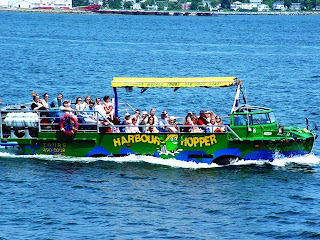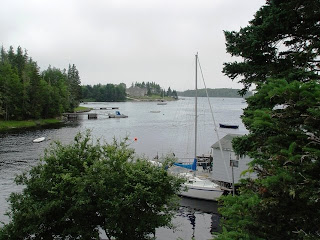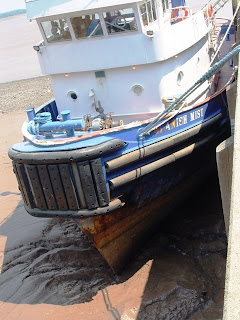
. Our view across the road in front of our RV.

The park is only five miles from
Peggys Cove. It is the largest RV park near Halifax with 125 sites. The owner and his family have run the park for decades. We took a site with 50-amp service, but we moved the next day to the site across the road with 30-amps due to a better view and our satellite works. We also extended our stay a week as there is so much to do in the area and weather is so unpredictable.

Nova
Scotia is a “big” kind of seacoast experience.
The world’s highest tides rise and fall in the Bay of Fundy - a couple of billion liters of water coming and going twice a day with North America’s largest tidal range. Fifteen different species of whales hang out for the summer enjoying the great seafood. There are 4,750 miles of coastline so you are never more than two hours drive from the sea. Diverse landscapes. Pristine white beaches on the South Shore. Signature red sands on the
Northumberland Shore with the warmest waters on the East Coast. Cobblestone beaches and massive granite boulders of the world-famous
Peggy’s Cove. Lighthouses aplenty. Canada’s most iconic sailing ship, the Bluenose II finds its home in the World Heritage Town of
Lunenburg.
The surf in Nova
Scotia is gaining a worldwide rep as simply wicked.
Lawrencetown Beach, half an hour from downtown Halifax, serves up four seasons of great surf. The second smallest province in Canada (after PEI) is home to almost one million people, nearly half live in Halifax.

The term “
Bluenoser” likely grew out of descriptions of fishermen who wore the traditional homemade sweaters that were dyed a dark blue. The fog was often thick on the seas, and when a fisherman’s nose required wiping and his hands not free he used his sleeves. The moist dye rubbed off onto noses, and the term “
Bluenoser” was born. There are still working fishing villages to be found, some of which include boat builders.

Nova Scotia has been under both British and French rule. The French established a settlement at Port-Royal in 1604, the fort, near Annapolis Royal, has been restored as a National Historic Site. It was here that Samuel de Champlain proclaimed the Order of Good Cheer, a social club dedicated to feasting and celebration, to help his men endure those first cold winters. It was also here that Membertou, chief of the area’s Mi’kmaq, established a cooperative relationship with the colonists. French settlers planted a vineyard, marking the start of a wine industry that is flourishing today.
Louisbourg was founded in 1713 on the eastern side of Cape Breton to serve as defensive purposes and base for fishery. Louisbourg is Canada’s most famous National Historic Site and its largest reconstruction project. In 1758, the fortress was finally taken by the British and dismantled.
There are few places in the world with history as colorful and captivating as Nova Scotia. They nurture it, celebrate it, and rejoice in it. From the rum-runners during prohibition to the quiet courage of coal miners, the rough and ready saltbank schooner era of wooden boats and iron men.
.
Sunday, July 20 - Around 10 am we drove toward
Lunenberg. Along the route, we saw hundreds of pram sailboats on St.
Margarets Bay. (When Samuel
de Champlain explored the New World in Opening south directly onto the Atlantic, its eastern shore is formed by the
Chebucto Peninsula and its western shore by the
Aspotogan Peninsula, while the head of the bay (the northern shore) is the main part of the Nova
Scotia peninsula., he noted St. Margaret’s Bay in his ship’s log.
The bay's shores are mostly rocky, although the head of the bay offers several sandy beaches.
 St. Margaret's Bay
St. Margaret's Bay is a cruising destination for sailing yachts and its picturesque shorelines offer protection in many natural harbours, as well as anchorages in coves and near small islands. Pockets of fog reached inland along the drive on Highway 103. The terrain was filled with fir trees on both sides of the road.
We came to the small town of
Mahone. The harbor is beautiful and there were three churches on the main road with the Lutheran church ringing its bell to alert all to come to their 11:00 am service. One very remarkable structure had the words
“Holiness to the Lord” engraved on the front stone.

 Mahone Bay
Mahone Bay is considered one of the
most attractive towns in Canada and the view across the harbour of its three prominent churches,
Anglican,
Lutheran, and
Church of Canada has appeared on many postcards and calendars. The town is filled with upscale shops and restaurants, which almost universally are designed to appeal to the tourist trade, and sometimes shut down during the winter months. Known for a history of wooden boat building, it was the main industry of
Mahone Bay in its earlier years. The first settlers founded the town in
1754 and were mostly German and Swiss.
In 1995,
UNESCO named this 250-year-old town of
Lunenburg a World Heritage Site. We arrived in
Lunenberg and wanted to get a bite to eat. We saw a restaurant overlooking the harbour on the second floor. It is called Big Red’s (was originally the
Old Lunenburg Jail) and we had a great lunch.

I ordered the famous
Donair Sandwich made with baked pizza crust and stuffed with shaved beef, lettuce, tomato and plenty of sauce on the side. The sandwich seems similar to famous Gyro (Greek) sandwich, but without the lamb. I loved it! Ray selected a fried fish sandwich and it was good as well.

We then went to the
Fisheries Museum of the Atlantic, housed in the former fish processing plant on
Lunenburg’s historic waterfront. Three floors contain many unique opportunities to explore the strange and fascinating world of the sea creatures. They also have staff that answer any questions and give detailed information about such subjects as the North Atlantic
lobster. There is much to see and do at this museum and is an excellent place for kids and adults alike to learn about this culture. It certainly educates visitors of the Atlantic Canada’s seafaring heritage.


The
Teresa E. Connor sits in the harbor and was launched in 1938 - a two-masted schooner, built to go “salt banking” (preserving fish in salt). It is now owned by the Museum.


In Old Town
Lunenburg, dozens of historic buildings and homes dating back to 1760 have been beautifully maintained. We took several pictures of downtown
Lunenburg. This was just one of many of the unique shops they have available even on Sunday.
Monday, July 21 -News from
HALIFAX - “Tropical storm Cristobal is expected to dump heavy rain on parts of Atlantic Canada over the next three days, according to the Canadian Hurricane Centre. Cristobal, which was still about 250 kilometres off the Virginia coast Monday morning, was moving to the northeast at 19 km/h with maximum winds of 83 km/h. It was expected to bring rain, at times heavy, to southern New Brunswick on Monday and to Nova Scotia and Newfoundland by Tuesday and Wednesday.” Needless to say, as
Floridians, we are accustomed to tropical storms, but had no idea we would encounter one while we were this far up the northern Atlantic coast. The good news is it wasn't as bad as expected.
- We took a drive to
Peggy’s Cove around 2:00-pm and found the sun shining and beautiful scenery. Peggy’s Cove is one of the most photographed locations in Canada. It is a small picturesque fishing village (pop. 120) that surrounds a narrow ocean inlet, which provides safe haven for boats during the Atlantic’s rough weather. The lighthouse you see was built on the large smooth wave-washed granite rocks and is the crowning feature of this beautiful Atlantic cove.






 Thursday, July 24
Thursday, July 24 - Although the weather was fog and mist, we drove to
Halifax to see some of the sites. We spent so much time at the
Citadel, we changed our plans to explore more and went to the IMAX Theater instead to see the new movie, Dark Knight. Heath Ledger was fantastic and we felt it very sad knowing he died of the overdose and will not get to see how popular he has become. Seeing the movie at an IMAX was well worth it with all the high-speed chase scenes, etc.
The population of
Halifax is approximately 373,000 (more than one-third of Nova Scotia’s population). Halifax has over 250 miles of coastline. Their port is the
world’s second largest natural harbour, deepest harbour ice-free year round. Halifax is celebrating 250 years as a naval port. Parks Canada runs the
Halifax Citadel National Historic Site of Canada on Citadel Hill (aka Ft. George). The 18th century star-shaped British military base is in the center of Halifax. The fortification has steep masonry walls surrounded by a ditch up to 9 meters deep. The rooms have very low doorways,
uneven steps and floors. Gun openings in the earthen walls slope directly into the ditch and are especially slippery and dangerous when wet. The restoration of this historic treasure is state-of-the-art. They have two film presentations to help bring you up to speed with the historical significance of the fort. We were very fortunate to see the guards carry out their drills on the grounds during our visit. The Citadel is obviously a great vantage point for viewing the harbour.
 The Halifax Defenses
The Halifax Defenses - The British established Halifax along the eastern shore of Nova Scotia in
1749. Citadel Hill has served as the site of four different forts. Each was built during a time of perceived threat. The Citadel you see today was the last to be built, and took over 28 years to complete. Finished in 1856, it was intended to deter an overland assault on the city and dockyard. Such was the strength of the Citadel and harbor defenses that no enemy ever dared attack. In 1906, the British garrison was withdrawn to help with the European conflict leading up to the First World War. During two world wars, the Citadel served as a sentinel on the home front and a symbol for those departing overseas. In 1952, the Citadel was declared a national historic site. The tall masts were used for communications.
 December 17, 1917 - Two square miles of Halifax lay in ruins and thousands dead when the French (Mont Blanc) munitions boat collided with Belgian (Imo) relief ship and blows up.
December 17, 1917 - Two square miles of Halifax lay in ruins and thousands dead when the French (Mont Blanc) munitions boat collided with Belgian (Imo) relief ship and blows up.

78th Highland Regiment

North America’s oldest operating NAVAL CLOCK (1772) looking down on the site of the landing of the first settlers to
Halifax.

We missed seeing a lot of the

downtown of Halifax on our second trip due to time constraints, but we enjoyed Historic Properties boardwalk and the fantastic view of the
Halifax Harbor.


It was a nightmare to get downtown due to construction crews redirecting traffic. Ray and our GPS were not doing well, to say the least. When we finally found Historic Properties signage, we had to navigate the busy streets to find parking. The first parking garage attendant said our truck would make the 6’ clearance, but Ray decided to go to the next garage down the street… it also had 6’ clearance. The next garage was the Casino parking garage with 6’2” clearance. Ray drove the truck cautiously under the first bar and the antennae did hit, but we made it. We figured out how to get in the Casino and used their air conditioned over-ground walkways to get to the wharf area and eat lunch.
You haven’t experienced
Halifax until you visit the
Historic Properties. Anchoring the city’s downtown core, the district hearkens back to the great Age of Sail, when merchant ships, privateers and naval ships plied the Harbour waters. Seafarers built this city, and the wharves and warehouses that were the base of operation later became known as the Historic Properties. Noteworthy buildings of the period include the Privateers Warehouse, which was built to support the activities of the daring sea captains who plundered enemy ships for the Crown. In the 1960s, the buildings were slated for destruction in the name of urban renewal. Luckily, some farsighted citizens fought the move, and
saved the buildings. Their actions really preserved the heart of the city. Each of these sites has been lovingly restored, with an emphasis on maintaining their unique history and atmosphere for you to experience.
Many of the building
Historic Properties-Privateers Wharf features daily year-round shopping along with great food in wonderful surroundings. Shops and restaurants are located in a number of interconnected buildings, making this an ideal destination in any season or weather. These historic buildings had to be stripped down to their old wood and stone shells to recapture their former glory. The harbor looks over at Dartmouth and the ferries run every hour back and forth between these two large cities. Amazing modern architecture of the skylines.







Friday, July 25 - We had a 9-am grooming appt. for Mitzy. She looked great. The cost was out of line with the states though, at $56.50 at Healthy Hound - cute name. We did our grocery shopping as well at Sobeys and love the store. Since the sun finally came out burning off the fog and mist, Ray drove out to take some pictures of the area.
Sunday we drove to another area where you can see coastal Hantsport and more of the Bay of Fundy, north of our area. Hantsport is steeped in a history of wooden ships and iron men, and is very picturesque. It took longer than expected.

We stopped along the way at the town of
Windsor the
birthplace of
hockey in the 1800s. Windsor was the site of a vibrant shipbuilding industry in the 1800s. With the introduction of the steel-hulled, power-driven ships in the 1890s, there was little need to continue building wooden sailing ships for commercial trade. All that remains of a once-thriving industry are the remnants of wharfs, slips and pilings.

We stopped at
The Churchill House, a grand beautiful Victorian home tucked among stately cedar and oak trees. The Churchill House was built by Ezra Churchill in 1860 for his son John Wiley Churchill as a wedding gift.

We drove up a hill to see
Fort Edward National Historic Site. There is only one building remaining, but the view of the surrounding area was worth the stop.
Fort Edward played an important role in securing British rule in Nova Scotia in the 1750s, as Britain and France battled for control of North America during the Seven Years War. With the onset of the American Revolution, soldiers of the 84th Regiment garrisoned the fort. Once the risk of an American invasion decreased, however, Fort Edward’s importance declined and it fell into disrepair. The picture is of the
last surviving Blockhouse in Nova Scotia. Erected by Charles Laurence in 1750. 

































































